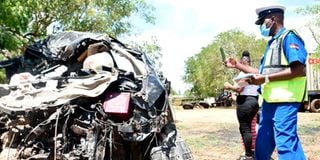Deaths, injuries in road accidents rise sharply

A traffic police officer takes a photo of a wreckage of a van that collided with an oil tanker at Taru area along the Mombasa-Nairobi Highway on May 8. The number of accidents has increased significantly from last year.
What you need to know:
- Pedestrians accounted for the largest number of deaths, with at least 1,111 cases recorded this year.
- Drivers’ deaths also increased this year, with 311 losing their lives compared to last year’s 213.
Kenyan roads are getting more dangerous, with the latest data showing the number of deaths recorded this year to have increased to a high of 3,212 up from 2,560 at the same time last year.
Traffic commandant Mary Omari attributed the sharp rise to most road users’ failure to follow traffic rules, and poor signage.
The number of crashes recorded this year also increased sharply, with at least 7,180 accidents having occurred compared to 5,877 last year.
Pedestrians accounted for the largest number of deaths, with at least 1,111 cases recorded this year, a sharp increase compared to last year’s 927. At least 891 motorcyclists and an additional 318 pillion passengers have been killed on the roads this year.
Drivers’ deaths also increased this year, with 311 losing their lives compared to last year’s 213. Passenger deaths shot up from 331 in 2020 to 520 this year.
The only transport means that recorded a decrease in deaths was that of bicycle riders, whose numbers were 63 in 2020 and 61 this year.
Serious injuries in accidents increased from 5,175 to 7,018 while those who sustained slight injuries shot from 3,295 to 3,938.
Ms Omari also revealed that more than 4,000 vehicles are currently on Kenyan roads without inspection, which automatically makes them unroadworthy. Deputy Inspector-General of Police Njoroge Mbugua warned the owners and drivers of the vehicles that had not been inspected that police will not compromise.
“The police don’t have the responsibility of taking vehicles for inspection, it is the owners’ duty. However, it is the police’s duty to ensure that all persons found to be driving vehicles that don’t have an inspection sticker are charged in court,” he said.
Mr Mbugua noted that the northern corridor, stretching from Mombasa to Busia, remained the most dangerous, with a “huge percentage” of the recorded deaths.
Nairobi, Nakuru Kericho and Kakamega counties were noted as most dangerous.
Director of technical services at the National Transport and Safety Authority (NTSA) Gerald Wangai said that, in addition to the inspection of vehicles, the agency was working to ensure the roads were safe for all road users.
Improve safety
He revealed that NTSA had initiated road audits across the country and that the results have helped it to improve safety.
An audit of Outering Road, for example, revealed that not only were there no sections set aside for bicycle and motorcycle riders, there are no standard paths for pedestrians either.
“We also did an audit at Salgaa and this saw the setting up of the barrier and the improvement of the road designs, which have so far helped reduce accidents there,” Mr Wangai said.
Mr Joshua Wamukata, the Nairobi traffic boss, warned matatu operators plying Thika Road, who drop off passengers along the Guru Nanak to Ngara stretch, that there is no designated bus stop there. He said the police would continue to arrest any matatu crew found breaking the law.
“We will not allow stopping of any sort along that stretch when NMS (Nairobi Metropolitan Service) is working to ensure that Nairobi’s transport sector is flourishing and is almost opening up the new Green Park and Park Road bus parks for use by the public transport. We have to abide by the rules,” he said.





